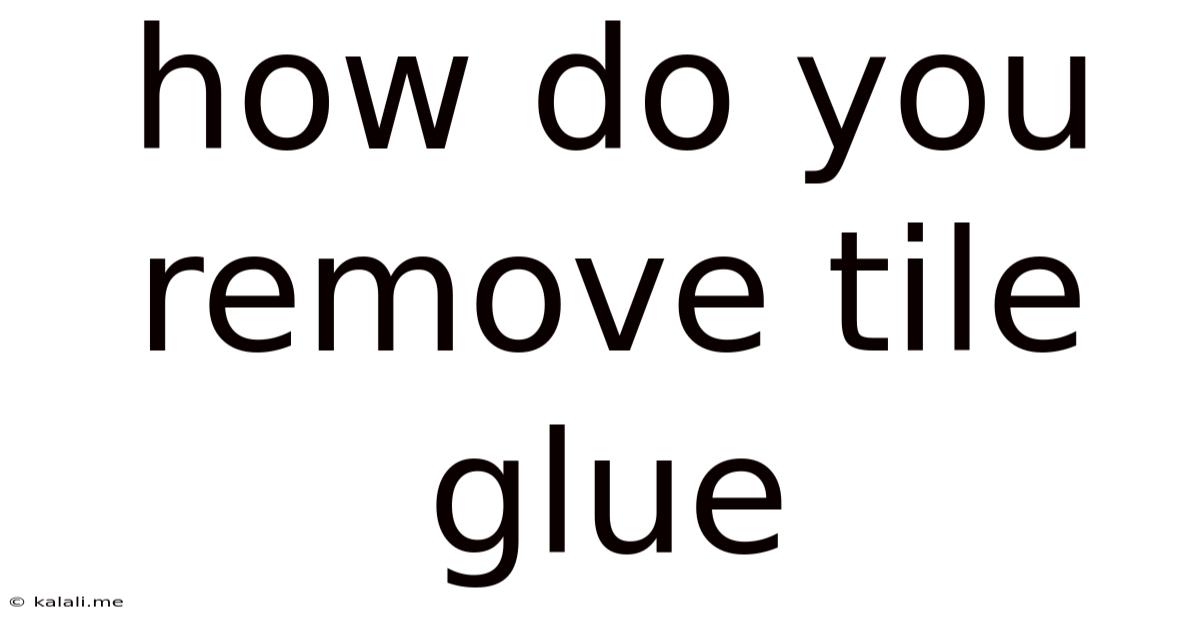How Do You Remove Tile Glue
Kalali
Jun 10, 2025 · 4 min read

Table of Contents
How to Remove Tile Glue: A Comprehensive Guide
Removing tile glue, also known as thin-set mortar, can be a challenging but achievable DIY project. This comprehensive guide will walk you through various methods, depending on the type of glue, the surface it's adhered to, and the tools you have available. Whether you're renovating your bathroom, kitchen, or tackling another tiling project, knowing how to effectively remove tile glue is crucial for a smooth and successful outcome.
Understanding Tile Glue and its Removal Challenges
Tile glue, primarily composed of cement, sand, and polymers, bonds tightly to various surfaces like concrete, wood, and drywall. The difficulty in removal depends on several factors:
- Type of Glue: Different formulations have varying bonding strengths. Modified thin-set mortars, often used for larger tiles, are generally more difficult to remove than standard thin-set.
- Surface Material: Porous surfaces like drywall absorb the glue more readily, making removal more challenging. Non-porous surfaces like ceramic tiles are usually easier.
- Age of the Glue: Older, cured glue is significantly harder to remove than fresh glue.
Methods for Removing Tile Glue
Several methods exist for removing tile glue, each with its strengths and weaknesses. The best approach depends on the specific circumstances.
1. Manual Removal with Scrapers and Chisels
This is often the first approach, especially for smaller areas or loose glue.
- Tools: Putty knives (various sizes), chisels, scraper, safety glasses, gloves.
- Process: Gently pry at the edges of the glue with a putty knife or chisel. Work slowly and carefully to avoid damaging the underlying surface. For stubborn glue, use a scraper to chip away at it.
Pros: Relatively inexpensive and readily available tools. Cons: Time-consuming, labor-intensive, and can damage the underlying surface if not done carefully. Not suitable for large areas or extremely stubborn glue.
2. Chemical Removal with Tile Glue Removers
Chemical removers are designed to soften and break down the glue, making it easier to remove.
- Tools: Chemical remover (follow manufacturer instructions), scraper, putty knife, safety glasses, gloves, ventilation.
- Process: Apply the remover according to the manufacturer’s instructions. Allow sufficient time for it to penetrate and soften the glue. Then, scrape away the softened glue with a putty knife or scraper. Remember proper ventilation and safety precautions.
Pros: Effective on stubborn and cured glue. Can significantly reduce labor. Cons: Can be expensive. Requires careful handling due to chemical nature. May damage certain surfaces if not used correctly.
3. Heat Application (for stubborn areas)
Heat can soften the glue, making it more pliable and easier to scrape.
- Tools: Heat gun or hairdryer, scraper, putty knife, safety glasses, gloves.
- Process: Apply heat carefully to the glue, avoiding overheating the underlying surface. The glue should soften and become more easily removable. Scrape away the softened glue.
Pros: Effective for stubborn areas. Cons: Requires careful control to avoid damaging surfaces. Not suitable for all surfaces (e.g., heat-sensitive materials). Can be time-consuming.
4. Mechanical Removal with Power Tools (for large areas)
For large areas, power tools can significantly speed up the process.
- Tools: Angle grinder with a diamond blade (or similar), vacuum cleaner, safety glasses, respirator, gloves, hearing protection.
- Process: Use the power tool cautiously to grind away the glue. This method is extremely effective but requires skill and caution to prevent damage. Vacuum frequently to remove dust and debris.
Pros: Fast and efficient for large areas. Cons: Requires skill and experience. Can generate significant dust and noise. High risk of damaging the underlying surface.
Choosing the Right Method
The optimal method depends on the situation. Consider:
- Glue type and age: Stubborn, old glue often requires chemical removal or heat application.
- Surface material: Avoid methods that could damage the underlying surface.
- Area size: For large areas, power tools are most efficient, while manual removal suits smaller areas.
- Your skill level: Begin with less aggressive methods before resorting to power tools or strong chemicals.
Safety Precautions
Always prioritize safety:
- Wear safety glasses, gloves, and a respirator (when using chemicals or power tools).
- Ensure adequate ventilation, especially when using chemical removers.
- Follow manufacturer instructions carefully when using chemical removers or power tools.
By following these steps and choosing the appropriate method, you can successfully remove tile glue and prepare the surface for your next project. Remember that patience and careful technique are key to achieving the best results while minimizing damage.
Latest Posts
Latest Posts
-
Is Keri Russell Related To Kurt Russell
Jul 02, 2025
-
What Is Half Of 1 4 Teaspoon
Jul 02, 2025
-
How Many Cups In A Pound Of Hamburger Meat
Jul 02, 2025
-
Imagery Or Figurative Language From Romeo And Juliet
Jul 02, 2025
-
What Is A Quarter Of A Million
Jul 02, 2025
Related Post
Thank you for visiting our website which covers about How Do You Remove Tile Glue . We hope the information provided has been useful to you. Feel free to contact us if you have any questions or need further assistance. See you next time and don't miss to bookmark.